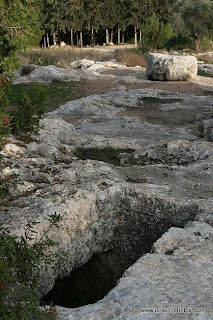The Tombs of the Maccabees.
Driving on road 443 from Neot Kedumim several kilometers further towards Jerusalem, you will notice large signs "Maccabean Graves - Hashmonean Village".
There you turn off from the main road, then turn left to the Maccabean Graves.
A group of Jewish schoolchildren initially discovered the graves on the eve of Hanukka 1907; they came to a site called Kubur al-Yahud, Arabic for "the graves of the Jews."
The graves are carved in rocks and covered by large boulders.
The place is still called "the graves of the Maccabees," even though it is clear that the structures there were constructed during the Byzantine period, long after Hasmonean times.
Therefore, the site of the "Graves of the Maccabbees" is actually not the correct site built by Simon the son of Mattathias the Priest for his father and his brothers, which is described in:
the Book of Maccabees I, chapter 13:
25 Simon sent for the remains of his brother Jonathan, and buried him in Modein, the city of his fathers.
26 All Israel bewailed him with solemn lamentation, mourning over him for many days.
27 Then Simon erected over the tomb of his father and his brothers a monument of stones, polished front and back, and raised high enough to be seen at a distance.
28 He set up seven pyramids facing one another for his father and his mother and his four brothers.
29 For the pyramids he devised a setting of big columns, on which he carved suits of armor as a perpetual memorial, and next to the armor he placed carved ships, which could be seen by all who sailed the sea.
30 This tomb which he built at Modein is there to the present day.
Judas Maccabeus (or Judah Maccabee, Hebrew: יהודה המכבי, Yehudah HaMakabi, Judah the Hammer) was the third son of the Jewish priest Mattathias.
He led the Maccabean revolt against Antiochus IV, who had persecuted the Jews and desecrated their temple (Seleucid Empire 167BCE-160 BCE)
Judah's forces were successful, conquering Jerusalem and reconsecrating the temple in 165 BCE. an accomplishment that is celebrated during Hanukkah (an eight-day Jewish festival of lights, beginning on the 25th day of the month of Kislev, which may fall anytime from late November to late December).
The Hasmonean era ended in 63 BC., when the Roman Emperor Pompey conquered Judea.
The site of the Maccabean Graves is described in manuscripts from the Byzantine period, by historian Eusebius in the fourth century CE, and it is depicted in a sixth century mosaic map at Madeba in Jordan.
In the last decade, two prominent candidates have been proposed as the site of ancient Modi'in: Khirbet Umm al-Umdan, in the area of the city of Modi'in, on a hill north of the road that connects it with Latrun and Titura Hill, an archaeological site in the heart of modern Modi'in.




